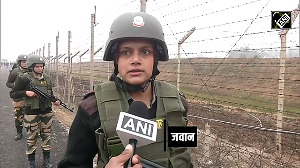An Insignificant Man gets full marks for its originality, says Utkarsh Mishra.

If the trailer of An Insignificant Man left you with the impression that it was a 'propaganda film' and an 'image makeover attempt' by the Aam Aadmi Party, then try to watch the entire film (the directors refuse to call it a documentary).
There are several reasons why it isn't one.
One, the movie focuses on the nascent stage of the Aam Aadmi Party that began soon after the conclusion of the dharna stage of India Against Corruption.
It closes with the party registering an unanticipated performance in the 2013 Delhi assembly election, the first it fought, and Arvind Kejriwal's swearing in as the chief minister for his first term.
Thus, it neither covers the activist phase of Kejriwal's life nor the one when his party decimated the Bharatiya Janata Party in the assembly election of 2015, at the peak of the Modi wave.
Any serious, well thought-out 'image makeover' attempt would have mandatorily included those two events.
Two, the movie offers no opinion. It has no sound bite by any 'expert'. Nor does it have any voice over or commentary.
It offers the viewers original footage of a political party in the making, a party which dared to challenge the might of two of the biggest national parties.
It leaves the job of drawing inference to the viewers.
Though it shows the Congress and the BJP only briefly -- the former in a little more detail than the latter -- it gives one the idea of their grandiloquent electoral campaigns versus the frugal one of the AAP.
The directors of the film -- Khushboo Ranka and Vinay Shukla -- shot the developments for over a year. A 96-minute film has been made out of 400 hours of tape.
Their final product reveals they took utmost care to be balanced. They haven't purged the unpleasant moments they had recorded.
Of course, we don't know how much was kept out from the 400 hours of tape. But enough of it has been retained for those who want to see the 'other side' -- how a party of newbies dealt with blows and jibes delivered by their mighty rivals, and how the leaders handled the discontent within.
There are many segments of party volunteers openly accusing the top leaders of 'drifting away from their ideals' and the latter not able to give a convincing answer.
Also, as the movie ends in 2013, along with the AAP's thumping 2015 victory, it also misses the spats and split thereafter which muddled the party's image.
However, one may spot the visible differences between Kejriwal and Yogendra Yadav even in the movie. Watch out for close-up shots of a frustrated Yadav in the movie. And the absence of dramatisation makes it easier for the audience to feel the emotions.
Overall, the film gets full marks for its originality.
It shows political novices learning on the job while on the campaign trail to a crucial assembly election -- how they ponder over ideas, slogans and issues before taking it to the public and how the seniors educate the juniors about the intricacies, how and why they come up with promises of reducing the electricity bill by half and giving 700 litres free water to every household daily.
It gives an opportunity to the viewers to see a leader when he is not uttering rehearsed lines in front of a crowd. Not many politicians like to show this face of theirs. And that's the most beautiful part of the movie.
One sees Arvind Kejriwal, the person in it. Not just the activist or the politician.
While we have seen him being slapped and smeared with ink on camera, we also get to see how he reacts later.
While we usually see a confident Kejriwal, we also get to see a nervous, apprehensive, confused Kejriwal.
While we usually see a valiant Kejriwal, declaring at the top of his lungs that he doesn't fear Narendra Modi or the Ambanis or Adanis, we also get to see an intimidated Kejriwal when documents are handed to him, allegedly proving 'corrupt practices' of the then government.
We see a broken Kejriwal, after one of his associates is killed.
Perhaps he then realises the power of his call, 'Hum darne wale nahi hain, chahe jaan bhi chali jaye (we won't back down, even if we're killed)'.
Look into his eyes and feel how someone who isn't a seasoned politician reacts on seeing a crowd of thousands in front of him, raising their hands and declaring their support in every eventuality.
Time and again, the camera points to the faces of people when he promises a corruption-free rule to them, some assured, some sceptical, but all of them certainly impressed.
It is also nice to see how a new force rises and succeeds in Indian democracy, despite all the opposition, intimidation, mockery, challenge and belligerence of the rivals.
Though many of us may believe the experiment has failed now, it was important to show how the experiment succeeded in the first place. And the movie does it beautifully.
It can be safely said that the movie once again raises the hopes that AAP did four years ago.












 © 2024 Rediff.com -
© 2024 Rediff.com -